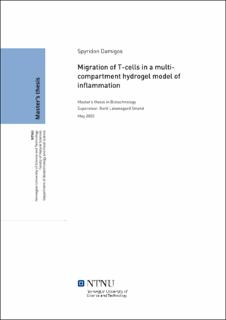| dc.description.abstract | In the present work multi-compartmental hydrogels were established in order to study T-cell migration in 3D. The main approach that was developed for the fabrication of the hydrogel systems, was based on the incorporation of an alginate compartment with an encapsulated bioactive factor, in a surrounding 3D matrix composed of collagen type-I, Matrigel or chemically modified alginate.
The resulted hydrogels were used as 3D in vitro platforms, in order to evaluate the migration of T-cells under the influence of pro-inflammatory mediators secreted by stimulated dendritic cells (DCs). DCs where encapsulated into the alginate together with lipopolysaccharide LPS that resulted to the activation of the TLR4 pathway, followed by the secretion of pro-inflammatory mediators. The stimulation of the DCs regulated the migration of the T-cell hybridomas embedded in the surrounding scaffolds. The multi-compartmental hydrogel system was successfully used to demonstrate migration in collagen type-I and Matrigel.
The activity of T-cell hybridomas in response to pro-inflammatory mediators was monitored in fibrillar collagen type-I matrix for the timepoints of 0h, 4h, 6h, 8h, 24h and 48h after the system was assembled, with live cell imaging. The results suggested an elevated accumulation around the alginate compartment throughout time in respect to the inflamed microenvironment that was exponentially increased at 48h. The migration in collagen-type I was in addition quantitated by automated cell tracking at the aforementioned timepoints. No significant differences were observed in terms of migrated distances and cell speed during the first 24h while at 48h the values were significantly increased. In general, the results indicated an increased migration of T-cell hybridomas under the influence of pro-inflammatory mediators with most critical timepoint that of 48h. The motility behavior of T-cell hybridomas was analyzed by mean squared displacement analysis and further discussed.
For multi-compartmental hydrogels where Matrigel was employed as a surrounding scaffold imaging took place at 0h and 96h. The T-cell hybridomas were shown to conglomerate forming a distinguishable line at the edge of the alginate structure at 96h under the presence of activated DCs. The results have indicated a directional migration to the endotoxin stimulated source. The same system was assessed in chemically modified alginates as a surrounding matrix. No activity was demonstrated in sulfated and partially oxidized-reduced (POAred) alginate hydrogels.
Pilot experiments were conducted in RGD-alginate hydrogels of different weight average molecular weight (Mw) compositions. The migration of T-cell hybridomas was recorded in both and Mw compositions. After one day of incubation the migration was increased within the hydrogels of both Mw compositions. The increased motility in the scaffolds after one day could be relevant to transitions that took place in the alginate network and altered the hydrogel architecture.
Lastly, a comparison in T-cell hybridomas morphology during migration in the different biomaterial scaffolds. Cell morphology was found to meet different attributes between the different biomaterials and could be linked to the surrounding matrix architecture.
In conclusion, multi-compartmental hydrogels based on fibrillar collagen and Matrigel with encapsulated alginate microstructures were successfully produced as an in vitro platform in order to study T-cell migration in 3D under the influence of an innate immune response. Alginate can be a good surrounding scaffold candidate in future setups since migration of T-cell hybridomas was determined within the hydrogels. | |
